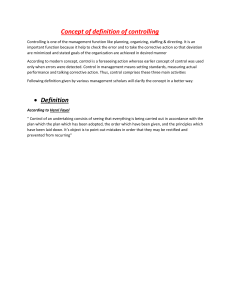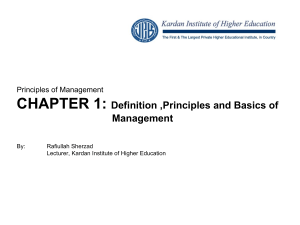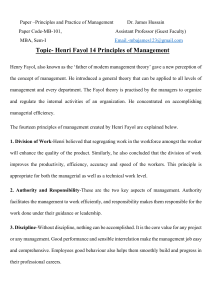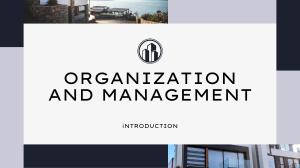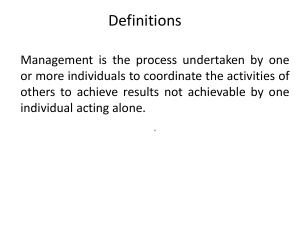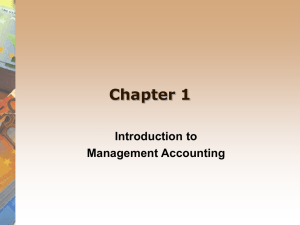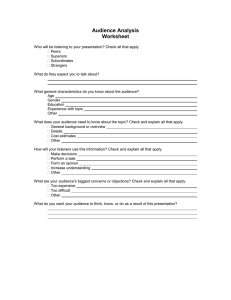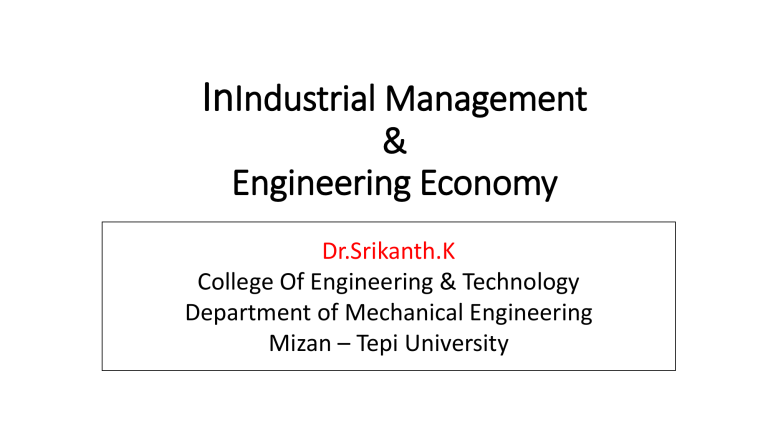
InIndustrial Management & Engineering Economy Dr.Srikanth.K College Of Engineering & Technology Department of Mechanical Engineering Mizan – Tepi University Out line of presentation Chapter-I Basic Management Concepts and Industrial Organization: Introduction to management; Functions of management; Organizational structure; Basics of productivity. Management- Definition 1 Management is the process of achieving goals and objectives effectively and efficiently through and with the people. 2 "Management is a process of designing and maintaining an environment in which individuals work together in groups to effectively and efficiently accomplish selected aims“. Management- Definition 3 Management is the process of achieving organizational goals and objectives effectively and efficiently by using management functions i.e. Planning – Organizing – Staffing – Controlling 4 Management is a set of activities directed at an organization's resources with the aim of achieving organizational goals in an efficient and effective manner. Elements of definition Process - represents ongoing functions or primary activities engaged in by managers Efficiency - getting the most output from the least amount of inputs. “doing things right” • concerned with means • Achieving the objectives in time. Effectiveness - completing activities so that organizational goals are attained • “doing the right things” • concerned with ends • Achieving the objectives on time. Efficiency and Effectiveness in Management Management: Science or Art? Management Science: Science is a collection of systematic knowledge, collection of truths and inferences (Logical thinking) after continuous study and experiments. It has fundamental principles discovered. Management Art : Art uses the known rules and principles and uses the skill, expertise, wisdom, experience to achieve the desired result. Management Science & Art : Management is both art and science. Management has got two faces like a coin; on one side it is art and on the other it is science. Management has got scientific principles which constitute the elements of Science and Skills and talent which are attributes of Art. Fayol’s Principles of Management Henri Fayol (1841-1925) He has proposed that there are 6 primary functions of 1.Forecasting,2.Planning, management 3.Organizing, 4.Commanding, 5.Coordinating, 6.controlling and 14 principles of management, There are 14 Principles of Management described by Henri Fayol. Important of management (Fayol’s 6 Functions of Management) Process designed to achieve an organization’s objectives by using its resources effectively & efficiently in a changing environment Make decisions – utilization of resources – achieve objectives: • Forecasting • Planning • Organizing • Staffing • Directing • Controlling New Product Development functions of management For attainment of objectives, every organization has a group of person for managing its affairs. It is concerned with productivity, effectiveness and efficiency by performing various managerial functions. Henry Fayol, the father of principles of management described various functions of management as : 1. 2. 3. 4. 5. Forecasting and planning Organizing Staffing Controlling and Coordinating. Planning Planning is the process of establishing goals and suitable courese of action for achieving those goals. Planning involves setting the ‘right’ goals and then choosing the ‘right’ means for attaining those goals Planning is necessary to ensure proper utilization of resources (men, materials, machine, time, and money) to achieve the objectives. Planning is performed by the managers at all levels. Steps in Planning Following steps are taken by the planning manager for the purpous of planning. 1. Recognition of the need for planning 2. Establishing objectives 3. Building the premises for planning 4. Identifying alternative course of action 5. Selecting a best course of action Advantages of Planning 1. Planning gives direction 2. Planning helps of at least changes and uncertainty 3. Planning helps in economic operation 4. Planning focuses attention of important activities 5. Planning helps in controlling 6. Planning helps in growth Types of Planning Plan Standing or Repeated use planes Single –use plane Kinds of Enterprise plane Time plans Organizing Organising is providing everything essential for proper functioning and combining the human power with other resources to give desired output Organising involves the following: 1. Identification and classification or required activities 2. Grouping of activities necessary to attain objectives 3. Assignment of each group to a manager Guidelines for Good organisation A good organizing should have the following: i) Allotment of work ii) Grant of necessary authority iii) Distribution of work in different departments iv) Coordination among different department v) Able to avoid wastage of labour, money and materials Types of Organisation 1. Line or scalar organisation 2. Functional organisation 3. Line and staff organisation Staffing Staffing, now-a-days, also termed as human resources management is defined as filling and keeping filled positions in the organisation structure. Staffing function involves recruiting selecting, placing, promoting, appraising, carrier planning, training etc. Controlling Controlling function of management can be defined as : 1. Controlling is a continuous process of measuring actual results in relation to those planned 2. Controlling is a process which sets standards, measures job performance , and takes corrective action, if required 3. Controlling , find out the deviation and take corrective actions. Techniques of management control 1. Budget and budgetary control 2. Cost control and cost accounting 3. Inventory control 4. Quality control 5. Production control 6. Network techniques Coordinating Objectives of coordination: Following objectives are sough through coordination's: i) Reconciliation of goals ii) Economy and efficiency iii) Good personal relations iv) Helps in keeping high moral of employees Techniques of effective coordination 1. Clearly defined goals 2. Clear lines of authority and responsibility 3. cooperation 4. Effective leadership and supervision The following are the key of functions of management Selection of injection machine Functions of management (Fayol’s 6 Functions of Management) For attainment of objectives, every organization has a group of person for managing its affairs. It is concerned with productivity, effectiveness and efficiency by performing various managerial functions. Henry Fayol, the father of principles of management described various functions of management as : 1.Forecasting: The first function is to analyze the present and past information to predict the future and plan accordingly. 2.Planning: The top management plans a suitable course of action, based on the business forecast. Cont... 3.Organizing: The management next needs to systematically arrange the resources, i.e., raw material, capital and human resource as per the planning. 4.Staffing: Staffing, now-a-days, also termed as human resources management is defined as filling and keeping filled positions in the organisation structure. Staffing function involves recruiting selecting, placing, promoting, appraising, carrier planning, training etc. 5.Coordinating: In this function, the management should ensure proper synchronization among all the departments. For this purpose, weekly meetings can be held with the managers of all the departments. 6.Controlling: The managers need to evaluate the performance of the personnel by establishing the standards, comparing the actual performance with the desired one and implement the corrective measures accordingly. 14 Principles of Henri Fayol in management 1. Division of Labor 2. Authority & Responsibility 3. Unity of Command 4. Unity of Direction 5. Equity 6. Order 7. Discipline 8. Initiative 9. Remuneration 10. Stability of Tenure 11. Scalar Chain 12. Sub-ordination of Individual Interest to common goal 13. Espirit De’ Corps 14. Centralization 14 Principles of Henri Fayol in management 1. Division of Labor Work of all kinds must be divided & subdivided and allotted to various persons according to their expertise in a particular area. 2. Authority & Responsibility Authority refers to the right of superiors to get exactness (Accuracy) from their sub-ordinates. Responsibility means obligation (Duty) for the performance of the job assigned. Note that responsibility arises wherever authority is exercised. 3. Unity of Command A sub-ordinate should receive orders and be accountable to one and only one boss at a time. He should not receive instructions from more than one person 14 Principles of Henri Fayol 4. Unity of Direction People engaged in the same kind of business or same kind of activities must have the same objectives in a single plan. Without unity of direction, unity of action cannot be achieved. 5. Equity Equity means combination of fairness, kindness & justice. The employees should be treated with kindness & equity if devotion is expected of them. 6. Order This principle is concerned with proper & systematic arrangement of things and people. Arrangement of things is called material order and placement of people is called social order. 14 Principles of Henri Fayol 7. Discipline Discipline means sincerity, obedience, respect of authority & observance of rules and regulations of the enterprise. Subordinate should respect their superiors and obey their orders. 8. Initiative Initiative means eagerness to initiate actions without being asked to do so. Management should provide opportunity to its employees to suggest ideas, experiences & new method of work. 9. Remuneration Remuneration to be paid to the workers should be fair, reasonable, satisfactory & rewarding of the efforts. It should accord satisfaction to both employer and the employees 14 Principles of Henri Fayol 10. Stability of Tenure Employees should not be moved frequently from one job position to another i.e. the period of service in a job should be fixed. 11. Scalar Chain Scalar chain is the chain of superiors ranging from the ultimate authority to the lowest. Communications should follow this chain. However, if following the chain creates delays, cross-communications can be allowed if agreed to by all parties and superiors are kept informed. 12. Sub-ordination of Individual Interest to common goal An organization is much bigger than the individual it constitutes therefore interest of the undertaking should prevail (Hold) in all circumstances. The interests of any one employee or group of employees should not take precedence (Priority) over the interests of the organization as a whole. 14 Principles of Henri Fayol 13. Espirit De’ Corps It refers to team spirit i.e. harmony in the work groups and mutual understanding among the members. Espirit De’ Corps inspires workers to work harder. 14. Centralization Centralization refers to the degree to which subordinates are involved in decision making. Whether decision making is centralized (to management) or decentralized (to subordinates) is a question of proper proportion. The task is to find the optimum degree of centralization for each situation. Levels of management 1. Top Level: Top management sets the mission and goals, develops policies, evaluates the overall performance of various departments, responsible for the business as a whole and is concerned mainly with long-term planning 2. Middle Level: Middle level management develops departmental goals, executes the policies, plans and strategies determined by top management, develops medium- term plans and supervises and coordinate lower-level managers’ activities 3. Lower (Supervisory, frontline) Level: Lower level management takes charge of day-to-day operations, is involved in preparing detailed short-range plans, is responsible for smaller segments of the business, executes plans of middle management, guides staff in their own subsections and keep close control over their activities Levels of management Why Study Management? Universality of Management – The reality that management is needed • in all types and sizes of organizations • at all organizational levels • in all organizational areas • in all organizations, regardless of location Universal Need for Management Important of management A scientific management is most essential as it fulfills the following necessities: It maintains discipline by keeping proper control It distributes the work and machine among the workers to get maximum output It keeps co-ordinations among the staff It improves efficiencies It suggests new idea and improvements It develops means of marketing and publicity Areas of Management • • • • • • Finance Production Operations Human Resources Marketing Administration Areas of Management Financial Management – Focus on obtaining money necessary for the successful operations and using funds to further organizational goals Production & Operations Management– Develop & administer activities to transform resources into goods, services, and ideas for the marketplace. Areas of Management Human Resources Management – Handle staffing function and deal with employees in a formalized manner Marketing Management – Responsible for planning, pricing, and promoting products and making them available to customers Manager A manager is someone whose primary responsibility is to carry out the management process within an organization to achieve the organizational goals. Changing nature of organizations and work has blurred the clear lines of distinction between managers and non-managerial employees Managerial skills Managerial Primary skills Conceptual skills (Top Management): This refers to the ability to think and conceptualize abstract situations. These abilities are required for making complex decisions. In short it is: The mental capacity to develop plans, strategies and vision Changing nature of organizations and work has blurred the clear lines of distinction between managers and non-managerial employees Managerial Primary skills Human or interpersonal skills (Middle Management): This includes the ability to understand other people and interact effectively with them. The human skills are also important in creation of an environment in which people feel secure and free to express their opinions. In short it is: The ability to work with other people in teams Managerial Primary skills Technical skills (Low Management): • These skills include the knowledge, abilities of and proficiency in activities involving methods, processes and procedures in the relevant fields as accounting, engineering, manufacturing etc. Or in short: • The ability to use the knowledge or techniques of a particular discipline to attain ends Managerial Secondary skills Design skills: • These skills enable a manager to handle and solve any kind of unforeseen or actual problems, that may crop up in the organization. Such problems could arise due to internal factors or external factors and/or both. In short it is: • The problem solving skill Managerial Secondary skills Communication skills: • The abilities of exchanging ideas and information effectively. To understand others and let others understand comprehensively. Leadership skills • The abilities to influence other people to achieve the common goal. Managerial Secondary skills Leadership Skills The abilities or strengths shown by people in management roles that aid in guiding and encouraging a group of people and their team toward achieving a common goal or set of goals. Roles of manager Roles of manager A: Inter-personal Role Figurehead: Represents the company on social occasions. Attending the flag hosting ceremony, receiving visitors or taking visitors for dinner etc. Leader: In the role of a leader, the manager motivates, encourages, and builds enthusiasm among the employees. Training subordinates to work under pressure, forms part of the responsibilities of a manager. Liaison: Consists of relating to others outside the group or organization. Serves as a link between people, groups or organization. The negotiation of prices with the suppliers regarding raw materials is an example for the role of liaison. Roles of manager B: Decisional Role: 1. Entrepreneur: Act as an initiator and designer and encourage changes and innovation, identify new ideas, delegate idea and responsibility to others. 2. Disturbance handler: Take corrective action during disputes or crises; resolves conflicts among subordinates; adapt to environmental crisis. 3. Resource allocator: Decides distribution of resources among various individuals and groups in the organization. Roles of manager Informational role: 1. Monitor: Emerges as nerve center of internal and external information about Information. 2. Disseminator: Transmits information received from other employees to members of the organization. 3. Spokesperson: Transmits information to the people who are external to the organization, i.e., government, media etc. For instance, a manager addresses a press conference announcing a new product launch or other major deal Organizational structure Organizational structure Organizational structure refers to the way in which a group is formed, its lines of communication, and its means for channeling authority and making decisions. It clarifies the formal relationships of individuals in the various positions within the organization Why do we need an Organizational Structure ? All Organizations management have structure a that determines the relationships b/w functions and positions and subdivides and delegates roles, responsibilities and authority to carry out defined tasks. Organizational structure-Purpose Divides work to be done in specific jobs & dept. Assigns tasks and responsibilities associated with individual jobs. Coordinates diverse organizational tasks. Establishes relationship b/w individuals, groups and departments. Establishes formal lines of authority. Allocates organizational resources. Clusters jobs into units. IMPORTANCE OF ORGANIZATIONAL STRUCTURE It enables members to know what their responsibilities It frees the manager and the individual workers to concentrate on their respective roles and responsibilities It coordinates all organization activities so there is minimal duplication of effort or conflict. Avoids overlapping of function because it pinpoints responsibilities. Shows to whom and for whom they are responsible ORGANIZATIONAL RELATIONSHIP ORGANIZATIONAL RELATIONSHIP FORMAL STRUCTURE INFORMAL STRUCTURE FORMAL STRUCTURE Formal structure, through departmentalization and work division, provides a framework for defining managerial authority, responsibility and accountability. FORMAL STRUCTURE INFORMAL RELATIONS Informal structure is generally social, with blurred or shifting lines of authority and accountability. It also has its own channels of communication, which may distribute information more broadly and rapidly than the system. formal communication Informal Structure Types of Organizational Structure Organizational Structure Tall Flat Or or Centralized Organizational Decentralized Organizational Structure. Structure Centralized Organizational Structure Large, complex organizations often require a taller hierarchy. In its simplest form, a tall structure results in one long chain of command similar to the military. As an organization grows, the number of management levels increases and the structure grows taller. In a tall structure, managers form many ranks and each has a small area of control Centralized Organizational Structure ADVANTAGES: 1. DISADVANTAGES: The quality of performance will improve due to close 1. Tall Organization creates many levels of management. supervision. 2. There are many delays and distortion in communication. 2. Discipline will improve. 3. Superior - Subordinate relations will improve. 3. Decisions and actions are delayed. 4. It is very costly because there are many managers. The 4. Control and Supervision will become easy and convenient. 5. 5. The manager gets more time to plan and organize the future activities. The efforts of subordinates can be easily coordinated. 7. Tall Organisation encourages development of staff. There is subordinates mutual It is difficult to coordinate the activities of different levels. 6. There is strict supervision. So the subordinates do not 6. 8. managers are paid high salaries. trust between superior have any freedom. 7. Tall Organization is not suitable for routine and standardized jobs. and 8. Here, managers may became more dominating. Decentralized Organizational Structure. Flat structures have fewer management levels, with each level controlling a broad area or group. Flat organizations focus on empowering employees rather than adhering to the chain of command. By encouraging autonomy and self-direction, flat structures attempt to tap into employees’ creative talents and to solve problems by collaboration. Decentralized Organizational Structure. ADVANTAGES DISADVANTAGES 1. Flat Organization is less costly because it has 1. There are chances of loose control because there are only few managers. many subordinates under one manager. 2. It creates fewer levels of management. 2. The discipline in the organization may be bad due to loose 3. Quick decisions and actions can be taken because it has only a few levels of management. 4. Fast and clear communication is possible among these few levels of management. 5. Subordinates are free from close and strict supervision and control. 6. It is more suitable for routine and standardized activities. 7. Superiors may not be too dominating because of large numbers of subordinates. control. 3. The relations between the superiors and subordinates may be bad. Close and informal relations may not be possible. 4. There may be problems of team work because there are many subordinates under one manager. 5. Flat organization structure may create problems of coordination between various subordinates. 6. Efficient and experienced superiors are required to manage a large number of subordinates. 7. It may not be suitable for complex activities. 8. The quality of performance may be bad 5.Introduction To Productivity Productivity has now become an everyday watchword. It is crucial to the welfarae of the industrial firm as well as for the economic progress of the country. High productivity refers to doing the work in a shortest possible time with least expenµiture on inputs without sacrificing quality and with minimum wastage of resources. CONCEPT Productivity is the quantitative relation between what we produce and what we use as a resource to produce them, i.e. arithmetic ratio of amount produced (output) to the amount of resources (input). Productivity can be expressed as: Productivity = Out Put/Input. DEFINITIONOF PRODUCTIVITY Productivity is a function of providing more and more of everything to more and more people with less and less consumption of resources. PRODUCTION AND PRODUCTIVITY Production is defined as a process or procedure to transform a set of input into output having the desired utility and quality. Production is a value addition process. Production system is an organised process of conversion of raw materials into useful finished products represented as in Fig. Production system Cont... The concept of production and productivity are totally different production refers to absolute output whereas productivity is a relative term where in the output is always expressed in terms of inputs. Increase in production may or may not be an indicator of increase in productivity. If the production is increased for the same output, then there is an increase in productivity. Productivity can be Increased 1. When production is increased without increase in inputs. 2. The same production with decrease in inputs. 3. The rate of increase in output is more compared to rate of increase in input. Productivity Benefits Increase in income/profitability. Lowering running cost/operational costs. Maximising the use of all of the company’s resources such as land, equipments/machineries, factory, workers, and etc. Gaining a greater share of the market. More cash flows mean more opportunity for the company to expand and grow. 1. A company produces 160 kg of plastic moulded parts of acceptable quality by consuming 200 kg of raw materials for a particular period. For the next period, the output is doubled (320 kg) by consuming 420 kg of raw material and for the third period, the output is increased to 400 kg by consuming 400 kg of raw material. During the first year, production is 160 kg. Comments: From the above illustration, it is clear that, for second period, though production has doubled, productivity has decreased from 80% to 76%, for third, period production is increased by 150% and correspondingly productivity increased from 80% to 100%. Thus, Increase in production may or may not increase Productivity. RODUCTIVITY IMPROVEMENT TECHNIQUES The basic productivity improvement techniques are represented in the Fig. Productivity improvement techniques 1.Technology Based 1.Computer Aided Design (CAD), Computer Aided Manufacturing (CAM), and Computer Integrated Manufacturing System (CIMS). 2. Robotics 3. Laser technology 4. Modern maintenance techniques 5. Energy technology 6. Flexible manufacturing system (FMS) 2.Employee Based 1. Financial and non-financial incentives at individual and group level 2. Employee promotion. 3. Job design, job enlargement, job enrichment and job rotation 4. Worker participation in decision-making 5. Quality circles (QC), Small Group Activities (SGA) 6. Personal Development 3.Material Based 1. Material planning and control 2. Purchasing logistics 3. Material storage and retrieval 4. Source selection and procurement of quality material 5. Waste elimination 6. Material recycling and reuse 4.Process Based 1. Methods engineering and work simplification 2. Job design, job evaluation, job safety 3. Human factors engineering 5.Product Based 1. Value analysis and value engineering 2. Product diversification 3. Standardisation and simplification 4. Reliability engineering 5. Product mix and promotion 6.Management Based 1. Management style 2. Communication in the organisation 3. Work culture 4. Motivation 5. Promoting group activity

